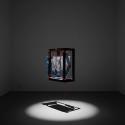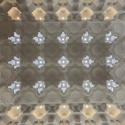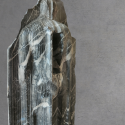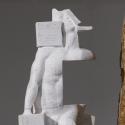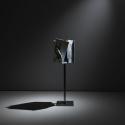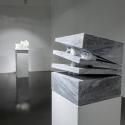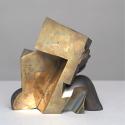Discipline
Abstract
Architectural / Monumental / Relief
Conceptual
Figurative / Realism
Installation
Material
Bronze
Granite/Marble/Stone
Metal (other)
Mixed media
Region
London
Europe
Biography
Biography
Vincenzo Muratore (b. 1985, Sicily) is a London-based sculptor, poet and performer. He holds an MA in Sculpture from the Royal College of Art (2024) and has a background in social sciences for international cooperation.
Muratore has developed a unique 'grammar of repair,' a methodology that merges traditional materials like salvaged marble with contemporary processes such as 3D modelling, robotic milling, and experimental cyanotype. His work, which spans sculpture, installation, and performance, creates anti-monuments that function as thresholds, cocoons, and vessels, exploring the tension between concealment and revelation.
He is a Lecturer at the University of East London and a Technical Instructor in marble processes at the Royal College of Art. Muratore has realised major public commissions and his work is held in public collections. He has exhibited across the UK and Italy.
Artist Statement
My practice is an archaeology of the self, an enquiry into the material inscription of memory, trauma, and identity. It operates within what Homi K. Bhabha terms the 'Third Space' : an interstitial and ambivalent site where personal and collective narratives are negotiated. Rooted in a Sicilian heritage defined by cultural syncretism, and informed by a queer and neurodivergent experience, my work seeks to give form to the complex, often contradictory, stratifications that constitute an identity. I do not represent the body; rather, I construct the sculpture as a body—an inscribed architecture, a vessel, a threshold—that critiques the monolithic and patriarchal structures demanding legibility and transparency.
The central engine of my work is the dialectic between concealment and revelation. This is not a formal game of hide-and-seek, but a political and psychological necessity. In an era that insists on total visibility, the act of concealing—of burying one sculpture within another, as in the White Wombs series —becomes a radical gesture of custodianship. It is an act of protection for the fragile, non-normative core of the self, echoing the poetic resistance of figures like Alda Merini, whose neurodivergent genius was confined and scrutinised. The sculpture thus becomes a cocoon, a sacred enclosure whose interior is revealed only partially, through calibrated fissures that choreograph the viewer's gaze and transform the act of looking into an intimate, perceptual ritual.
To articulate this process, I have developed a 'grammar of repair'. This methodology is both a physical act and an ethical stance. It originates from a direct engagement with trauma—notably the "anthropological cancellation" of the Belice territory in Sicily following the 1968 earthquake —and translates the civic act of architectural reconstruction into a personal, sculptural language. The suturing of fractured, salvaged marble with thread or metal is its most visible syntax. This act does not seek to erase the wound but to transform it into a structural and visible bond, a scar that testifies to a history of rupture and resilience. This grammar is further articulated in the dialogue between the precision of robotic milling and the intimacy of hand-finishing, an embodiment of the tension between systemic forces and individual agency.
My most recent work engages directly with what Marianne Hirsch defines as 'postmemory': the relationship of the second generation to the traumas of the first. My experimental use of cyanotype on stone is a material manifestation of this concept. By inscribing the marble with UV-resistant tempera and exposing it to light, an image is created through absence; the surface registers the spectral trace of a word or the shadow of the concealed sculpture within. The artwork becomes a photographic plate that has recorded not an event, but the memory of an event's absence. It is the materialisation of a story transmitted not by recall, but by "imaginative investment, projection, and creation".
Ultimately, my works are anti-monuments. They refuse the heroic, patriarchal rhetoric of the singular, triumphant form in favour of fragmentation, process, and the void. They are static objects that contain the memory of a ritual, be it the social ritual of burial explored in my performances or the psychological drama of 'contraction and release' inherited from Martha Graham. They are thresholds where geology meets psychology, where light reveals absence, and where the viewer is invited not to consume an image, but to participate in an archaeology of what it means to be.
Video Performance Throughout history, the burial ritual has been understood as crucial for preserving the memory of the deceased and simultaneously represents the final act of farewell. In my work, the burial ritual becomes a pivotal passage for expressing the collective vision of memory. Society's inherent tendency to quickly bury even precious events under layers of words and actions is highlighted. Collective memory is thus lost, concealed in a brutal ritual that, in the end, makes room for the ultimate action. with the support of the Royal College of Art video team Roddy Canasa, Gill Dibben, Harry Johns, Laura Selby videomaker Toyin Said assistant Marcello Liga
Live performance Way Out East Gallery, University of East London, 02/10/2024 Hidden solo exhibition Opening Performance Vincenzo Muratore performers Dominic Longworth and Vincenzo Muratore
In this performance, I write selected poems by Alda Merini alongside my own on a marble sculpture, using ink, pencil, and carving tools to explore the impact of words and the weight they hold. Each word becomes a lasting mark on the marble—some fading with time, others etched deeply, symbolising the enduring influence and varying strength of language. Through this layering of words, the performance reflects on how words leave imprints on our minds and bodies, the depth and permanence of their weight changing according to the emotions they evoke. As I inscribe each line, the marble itself transforms into a repository of thoughts, emotions, and memories, capturing the essence of Merini’s poetic legacy and my own reflections. The choice of marble as the canvas conveys both fragility and permanence, echoing the delicate yet powerful nature of words and their indelible effects on the human experience.
